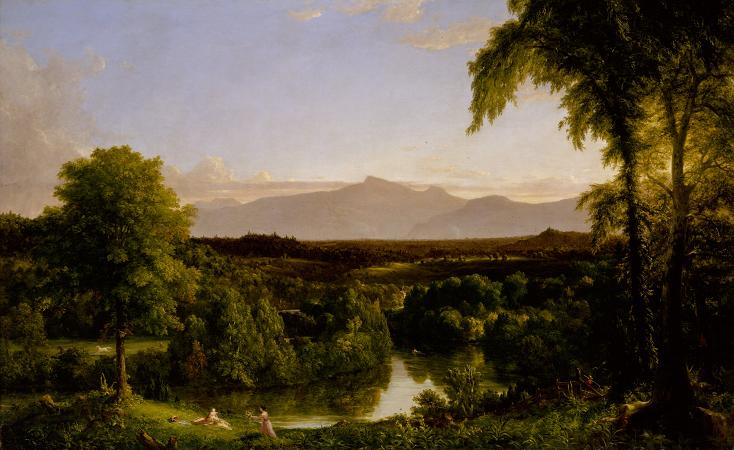Catskill Mountains. The Catskill Mountains, also known as the Catskills, are a physiographic province of the larger Appalachian Mountains, located in southeastern New York. As a cultural and geographic region, the Catskills are generally defined as those areas close to or within the borders of the Catskill Park, a 700,000-acre forest preserve forever protected from many forms of development under New York state law. Geologically, the Catskills are a mature dissected plateau, a once-flat region subsequently uplifted and eroded into sharp relief by watercourses. The Catskills form the northeastern end of the Allegheny Plateau. The Catskills are well known in American culture, both as the setting for films and works of art, including many 19th-century Hudson River School paintings, as well as for being a favored destination for vacationers from New York City in the mid-20th century. The region's many large resorts gave countless young stand-up comedians an opportunity to hone their craft. In addition, the Catskills have long been a haven for artists, musicians, and writers, especially in and around the towns of Phoenicia and Woodstock. Nicolaes Visscher I's 1656 map of New Netherland located the Landt van Kats Kill at the mouth of Catskill creek. The region to the south is identified as Hooge Landt van Esopus, a reference to a local band of northern Lenape Native Americans who inhabited the banks of the Hudson and hunted in the highlands along the Esopus Creek. While the meaning of the name and the namer are settled matters, how and why the area is named Catskills is a mystery. Mountain lions were known to have been in the area when the Dutch arrived in the 17th century and may have been a reason for the name. The confusion over the origins of the name led over the years to variant spellings such as Kaatskill and Kaaterskill, both of which are also still used: the former in the regional magazine Kaatskill Life, the latter as the name of a mountain peak and a waterfall. The supposed Indian name for the range, Onteora, was actually created by a white man in the mid-19th century to drum up business for a resort. It, too, persists today as the name of a school district and as the name of a Boy Scout summer camp. The Catskills are located approximately 100 miles north-northwest of New York City and 40 miles southwest of Albany, starting west of the Hudson River. The Catskills occupy much or all of five counties:, with some areas falling into the boundaries of southwestern Albany, eastern Broome, northwestern Orange, and southern Otsego counties. Foothills are also found in southeastern Chenango, southern Montgomery, northern Otsego, and western Schenectady counties. At the eastern end of the range, the mountains begin quite dramatically with the Catskill Escarpment rising up suddenly from the Hudson Valley. The western boundary is far less certain, as the mountains gradually decline in height and grade into the rest of the Allegheny Plateau. Nor is there a consensus on where the Catskills end to the north or south. The Pocono Mountains, to the immediate southwest in Pennsylvania, are a part of the Allegheny Plateau. The Catskills contain more than 30 peaks above 3,500 feet and parts of six important rivers. The Catskill Mountain 3500 Club is an organization whose members have climbed all the peaks in the Catskills over 3,500 feet. The highest mountain, Slide Mountain in Ulster County, has an elevation of 4,180 feet. Climatically, the Catskills lie within the Allegheny Highlands forests ecoregion. Catskill Mountains have two climate zones. The vast majority of the Catskills have a warm summer humid continental climate with valley elevations below 450 ft nearest the Hudson Valley having a hot summer humid continental climate. The plant hardiness zone on Slide Mountain at 4,180 ft is 5a with an average annual extreme minimum temperature of-16.6 °F. The plant hardiness zone in Ulster at 125 ft is 5b with an average annual extreme minimum temperature of-10.6 °F.
more...













